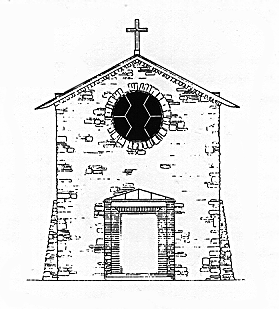
A Catalog of the Architectural Works of O'Neil Ford in Denton
An online version of a pamphlet published by the City of Denton Historic Landmark Commission in 1992
O'Neil Ford was arguably the most prominent architect to have come from Texas. In his long and distinguished career, he achieved both popular and critical success, yet retained a strong life-long link to his hometown of Denton.
Born Otha Neil Ford in Pink Hill, Texas in 1905, he moved to Denton in 1917 after the death of his father. His mother, Mrs. L.B. Ford, kept boarders in their home at 304 W. Avenue "D", just west of the campus of North Texas State Teachers College (now the University of North Texas). A graduate of Denton High School, Ford attended N.T.S.T.C. for two years, studying English and physics. Financial problems forced him to withdraw from college but he continued his studies through a correspondence course while working at Dyche's Corner, a hamburger stand at the corner of Avenue "A" and Hickory Streets.
In 1926, Ford took a position as an assistant to Dallas architect David Williams. His first work with Williams was drafting for the old First Presbyterian Church on South Elm Street (demolished in 1965). The first residence he designed was built in 1929 on North Bell Avenue. In this period, Ford designed an open air theater for the campus of N.T.S.T.C., and two structures that were never built, a 130 foot memorial tower and a student center.
Ford and his partner Arch Swank designed several residences in Denton in the late 1930s, but the high point of their Denton work in this period was the design and construction of the Little Chapel in the Woods on the campus of the College of Industrial Arts (now Texas Women's University). It was the Chapel, completed in 1939, which would propel Ford into a position of national prominence. Eleanor Roosevelt spoke to a crowd of 4,000 at the dedication on November 1, 1939.
His list of achievements is considerable. In 1960 Ford was made a Fellow of the American Institute of Architects. He was appointed to the National Council of the Arts by President Johnson and in 1974 would be declared a "National Historic Landmark" by the Council, the only individual ever so honored.
This correspondence school architect from Denton would lecture at Harvard, at Cambridge, become a Professor of Architecture at the University of Virginia and have a chair in architecture named after him at the University of Texas at Austin.
Among his best known works were the Little Chapel in the Woods, Trinity University in San Antonio, Skidmore College in New York, the Denton Municipal Building, the Tower of the Americas in San Antonio, the Bell Tower at the University of Dallas, and Texas Instruments buildings in Dallas, Italy, France and England.
Late in his career, Ford would recall the influences of his days in Denton and credit his pursuit of the creative life with his fascination with the Denton County Courthouse. Ford would say, "I used to just stand there, wondering how they ever got it up .... I was in Denton just the other day ... so I went over to look at the courthouse again and still don't know how they ever did that blasted, blessed thing."
O'Neil Ford died on July 20, 1982 in San Antonio, Texas.
Mike Cochran
Acknowledgements
This project owes much to many people. It is not possible to name all those that have
helped, but some names must be mentioned. Without the considerable assistance
of Roland Laney, Arch Swank, Ms. Toni LaSelle, Cynthia Bell, Nita Thurman,
Bill Farmer, Ron Forsythe, Richard Himmel, (UNT Archives),
Dawn Lettson, (TWU Blagg-Huey Library, Special Collections),
Carolyn Peterson, Ford Powell & Carson, Mary Carolyn George,
the City of Denton Historic Landmark Commission and the
City of Denton Planning Department,
this project would not have been possible.
This special World Wide Web edition is brought to you by Mike Cochran.
